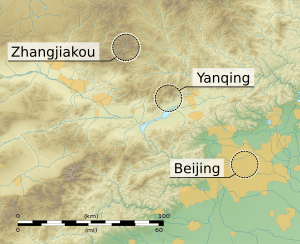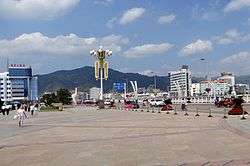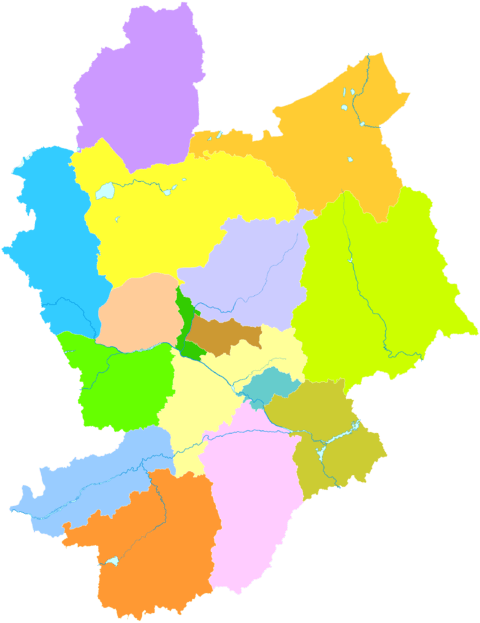Zhangjiakou
| Zhangjiakou 张家口市 | |
|---|---|
| Prefecture-level city | |
|
General view of Zhangjiakou | |
.png) Location of Zhangjiakou City jurisdiction in Hebei | |
 Zhangjiakou Location of the city centre in Hebei | |
| Coordinates: 40°46′N 114°53′E / 40.767°N 114.883°ECoordinates: 40°46′N 114°53′E / 40.767°N 114.883°E | |
| Country | China |
| Province | Hebei |
| Government | |
| • Party Secretary | Xing Guohui (邢国辉) |
| • Mayor | Hou Liang (侯亮) |
| Area | |
| • Prefecture-level city | 36,861.56 km2 (14,232.33 sq mi) |
| • Metro | 1,412.7 km2 (545.4 sq mi) |
| Elevation | 716 m (2,349 ft) |
| Population (2010 census) | |
| • Prefecture-level city | 4,345,485 |
| • Density | 120/km2 (310/sq mi) |
| • Metro | 838,978 |
| • Metro density | 590/km2 (1,500/sq mi) |
| Time zone | China Standard (UTC+8) |
| Licence plate prefixes | 冀G |
| Website |
zjk |
| Zhangjiakou | |||||||
|
"Zhangjiakou", as written in Chinese | |||||||
| Chinese name | |||||||
|---|---|---|---|---|---|---|---|
| Simplified Chinese | 张家口 | ||||||
| Traditional Chinese | 張家口 | ||||||
| Postal | Kalgan | ||||||
| |||||||
| Mongolian name | |||||||
| Mongolian script | ᠬᠠᠭᠠᠯᠭᠠᠨ | ||||||

Zhangjiakou (/ˈdʒɑːŋˈdʒjɑːˈkoʊ/),[1] also known by several other names, is a prefecture-level city in northwestern Hebei province in Northern China, bordering Beijing to the southeast, Inner Mongolia to the north and west and Shanxi to the southwest. At the 2010 census, its population was 4,345,485 inhabitants on 36,861.56 square kilometres (14,232.33 sq mi), divided into 17 Counties and Districts. The built-up (or metro) area made of Qiaoxi, Qiaodong Districts and Wanquan County largely being conurbated had 838,978 inhabitants in 2010 on 1412.7 km2. Due to its position on several important transport arteries, it is a critical transport node for travel between Hebei and Inner Mongolia and connecting northwest China, Mongolia, and Beijing.
Zhangjiakou will be one of the host cities at the 2022 Winter Olympics.
Names
Zhangjiakou is written 张家口 in simplified Chinese and 張家口 in traditional Chinese. It is Zhāngjiākǒu in pinyin and the name means "Zhang family gate." Older names for the town in Chinese include Zhāngyuán (張垣), used in the Republican era, and Zhāngjiāpù (張家堡).
Zhangjiakou was historically known to the Europeans as Kalgan (喀拉干, Kālāgàn) until the mid 20th century. This name derives from the Mongolian name of the city, ![]() , "Čiɣulaltu qaɣalɣa" (Classical Mongolian), "Chuulalt haalga" (modern Mongolian) or shorter,
, "Čiɣulaltu qaɣalɣa" (Classical Mongolian), "Chuulalt haalga" (modern Mongolian) or shorter, ![]() , "Qaghalghan" (Classical Mongolian), "Haalgan" (modern Mongolian), which means "the gate" (in the Great Wall). In Manchu, the city is known as
, "Qaghalghan" (Classical Mongolian), "Haalgan" (modern Mongolian), which means "the gate" (in the Great Wall). In Manchu, the city is known as ![]() (Imiyangga jase).
(Imiyangga jase).
Because of its strategic position above and northwest of Beijing, Zhangjiakou has been nicknamed "Beijing's Northern Door".
History

In August 1211, during the Battle of Yehuling, Genghis Khan's 90,000 strong force destroyed the 450,000 strong Jin dynasty army.
The water-scarce city was historically the chief northern gate in the Great Wall to China for Europeans travelling along the Northern Tea Road (such as Ivan Petlin (1619)[2] or Nicolae Milescu), often through the Juyong Pass.
From at least 1571 it was an important horse market for Mongolian mounts imported into China. From 1727 it was an important station for the Kyakhta trade between Russia and China. In early autumn long lines of camels would come in from all quarters for the conveyance of the tea chests from "Kalgan" (Zhangjiakou) to Kyakhta across the Gobi Desert. Each caravan usually made three journeys in the winter. In the 19th century some Russian merchants had permanent residences and warehouses just outside the gate.
In October 1909, Kalgan was connected by railway with Peking. The 1911 Encyclopædia Britannica noted that, in Kalgan, "the ordinary houses have an unusual appearance, from the fact that they are mostly roofed with earth and become covered with green-sward" and that "on the way to Peking the road passes over a beautiful bridge of seven arches, ornamented with marble figures of animals".
In 1937 the Japanese occupied the region and made Kalgan the capital of the autonomous Cha-nan (South Chahar) Province. The Federated Mengjiang Commission was set up to supervise the economic affairs, banking, communications, and industry of Japanese-occupied Inner Mongolia (Mengjiang).
In the early 1960s at the height of Sino-Soviet tensions, Zhangjiakou was considered one of the most important cities in China for military strategy reasons. Zhangjiakou was aptly nicknamed, "Beijing's Northern Door", because whoever controlled Zhangjiakou was in a good position to either attack (in the case of the Soviets) or defend (in the case of the Chinese) Beijing.
Zhangjiakou will host some of the events in the 2022 Winter Olympics.[3]
Tourism
Zhangjiakou is located in the north of Hebei Province, China, with 4 prefectures, 13 counties, 2 administrative zones, 1 hi-tech development zone and 1 industrial area under its administration. Zhangjiakou has 4.6 million people with a total area of 37,000 km2 (14,000 sq mi). In between the Mongolia Plateau and the North China Plain, it enjoys a favorable topography characterized by high mountains, deep valleys as well as rocky pathways. As a result, it makes a perfect natural screen for Beijing, which makes it a strategic priority militarily since the ancient times. It is named as "The Gateway to Beijing" and "The Mountain City beyond the Great Wall". The grand Yan Mountain, the towering Taihang Mountain, the vast grasslands, and the meandering Sangyang River converge here. The city government has regarded tourism as a major driving force of the city's economy and continues to develop the industry.
Economy

The vicinity of Zhangjiakou is rich in coal and iron ore, making it an ideal location for developing iron and steel industry. Apart from metallurgy, the city is home to one of China's most important grape wine industries, with the Great Wall Wine Company being located in Shacheng, Huailai County.[4]
Transportation
- The city lies in the northwestern corner of the province and is linked from Datong in Shanxi by the Xuanda Expressway and from Beijing by means of the Jingzhang Expressway.
- Zhangjiakou is further linked by a freeway to Inner Mongolia which opened on September 7, 2005.
- China National Highway 207
- A heavy-haul railway is under construction, to transport coal from Zhangjiakou to Tangshan. Construction is expected to finish in 2015; the railway is planned to carry 200 million tons of coal per year.[5] Another heavy-haul railway, Junggar-Zhangjiakou, is expected to connect to it.[6]
- Beijing-Zhangjiakou Intercity Railway is under construction.
Military
Zhangjiakou is headquarters of the 65th Group Army of the People's Liberation Army, one of the three group armies that comprise the Beijing Military Region responsible for defending China's capital.
Education
Zhangjiakou is home to Hebei North University. The university has been improving its international network and many foreign students are now studying there.
Geography and climate
Zhangjiakou is located in the northwest part of Hebei province, and is defined by mostly rough terrain created by the Yin Mountains, with elevations increasing from southeast to northwest. The east of the prefecture marks the Yan Mountains The bordering prefectures in the province are Chengde to the northeast and Baoding to the south. It also borders Shanxi to the west and southwest and Inner Mongolia to the northwest. The prefecture's latitude ranges from 39° 30' to 42° 10' N, or 289.2 kilometres (179.7 mi), while its longitude spans 113° 50' to 116° 30' E, or 216.2 kilometres (134.3 mi).
Zhangjiakou City is divided into three topographical regions: plateau, mountains, and basin. The former has elevations generally above 1,400 metres (4,600 ft), and consists of all of Guyuan and Kangbao Counties as well as part of Shangyi and Zhangbei Counties. This area is part of the southern end of the Inner Mongolia Plateau (内蒙古高原) and accounts for one-third of the prefecture's area.[7] The basin area has elevations of 500 to 1,000 metres (1,600 to 3,300 ft) and supports a few rivers.
Zhangjiakou has a monsoon-influenced, continental semi-arid climate (Köppen BSk), with long, cold, dry, and windy winters due to the Siberian anticyclone, and hot, humid summers driven by the East Asian monsoon; in between spring and autumn are dry and brief. Conditions are much cooler than in Beijing due in part to the elevation. The monthly 24-hour average temperature ranges from −8.3 °C (17.1 °F) in January to 23.7 °C (74.7 °F) in July, and the annual mean is 8.81 °C (47.9 °F).
| Climate data for Zhangjiakou (1971−2000) | |||||||||||||
|---|---|---|---|---|---|---|---|---|---|---|---|---|---|
| Month | Jan | Feb | Mar | Apr | May | Jun | Jul | Aug | Sep | Oct | Nov | Dec | Year |
| Record high °C (°F) | 9.7 (49.5) |
18.2 (64.8) |
22.6 (72.7) |
31.5 (88.7) |
36.8 (98.2) |
37.7 (99.9) |
39.2 (102.6) |
36.0 (96.8) |
33.5 (92.3) |
27.7 (81.9) |
20.4 (68.7) |
14.0 (57.2) |
39.2 (102.6) |
| Average high °C (°F) | −2.2 (28) |
1.5 (34.7) |
8.4 (47.1) |
17.9 (64.2) |
24.8 (76.6) |
28.5 (83.3) |
29.4 (84.9) |
27.7 (81.9) |
23.2 (73.8) |
16.3 (61.3) |
6.6 (43.9) |
−0.4 (31.3) |
15.1 (59.3) |
| Daily mean °C (°F) | −8.3 (17.1) |
−5.0 (23) |
2.0 (35.6) |
10.9 (51.6) |
17.8 (64) |
22.1 (71.8) |
23.7 (74.7) |
22.0 (71.6) |
16.6 (61.9) |
9.6 (49.3) |
0.5 (32.9) |
−6.2 (20.8) |
8.8 (47.8) |
| Average low °C (°F) | −12.9 (8.8) |
−10 (14) |
−3.6 (25.5) |
4.6 (40.3) |
11.2 (52.2) |
16.0 (60.8) |
18.7 (65.7) |
17.2 (63) |
11.2 (52.2) |
4.3 (39.7) |
−4 (25) |
−10.5 (13.1) |
3.5 (38.4) |
| Record low °C (°F) | −24.6 (−12.3) |
−21.9 (−7.4) |
−16.5 (2.3) |
−7.7 (18.1) |
−1.3 (29.7) |
5.1 (41.2) |
12.5 (54.5) |
7.2 (45) |
1.1 (34) |
−9.1 (15.6) |
−17.5 (0.5) |
−22.2 (−8) |
−24.6 (−12.3) |
| Average precipitation mm (inches) | 2.0 (0.079) |
4.1 (0.161) |
9.1 (0.358) |
14.0 (0.551) |
33.1 (1.303) |
60.6 (2.386) |
109.9 (4.327) |
100.5 (3.957) |
45.0 (1.772) |
16.9 (0.665) |
6.3 (0.248) |
2.1 (0.083) |
403.6 (15.89) |
| Average precipitation days (≥ 0.1 mm) | 1.7 | 2.5 | 4.6 | 4.8 | 7.6 | 10.2 | 13.4 | 12.8 | 9.1 | 4.3 | 2.6 | 1.7 | 75.3 |
| Source: Weather China[8] | |||||||||||||
Administrative divisions
| Map | ||||||
|---|---|---|---|---|---|---|
| Name | Hanzi | Hanyu Pinyin | Population (2004 est.) | Area (km²) | Density (/km²) | |
| Districts | ||||||
| Qiaoxi District | 桥西区 | Qiáoxī Qū | 230,000 | 141 | 1,631 | |
| Qiaodong District | 桥东区 | Qiáodōng Qū | 260,000 | 113 | 2,301 | |
| Xuanhua District | 宣化区 | Xuānhuà Qū | 590,000 | 2,371 | 248 | |
| Xiahuayuan District | 下花园区 | Xiàhuāyuán Qū | 70,000 | 315 | 222 | |
| Wanquan District | 万全区 | Wànquán Qū | 220,000 | 1,158 | 190 | |
| Chongli District | 崇礼区 | Chónglǐ Qū | 120,000 | 2,326 | 52 | |
| Counties | ||||||
| Zhangbei County | 张北县 | Zhāngběi Xiàn | 370,000 | 4,232 | 87 | |
| Kangbao County | 康保县 | Kāngbǎo Xiàn | 280,000 | 3,365 | 83 | |
| Guyuan County | 沽源县 | Gūyuán Xiàn | 230,000 | 3,601 | 64 | |
| Shangyi County | 尚义县 | Shàngyì Xiàn | 190,000 | 2,621 | 72 | |
| Yu County | 蔚县 | Yù Xiàn | 460,000 | 3,216 | 143 | |
| Yangyuan County | 阳原县 | Yángyuán Xiàn | 280,000 | 1,834 | 153 | |
| Huai'an County | 怀安县 | Huái'ān Xiàn | 250,000 | 1,706 | 147 | |
| Huailai County | 怀来县 | Huáilái Xiàn | 340,000 | 1,793 | 190 | |
| Zhuolu County | 涿鹿县 | Zhuōlù Xiàn | 330,000 | 2,799 | 118 | |
| Chicheng County | 赤城县 | Chìchéng Xiàn | 280,000 | 5,238 | 53 | |
See also
Notes
- ↑ "Zhangjiakou pronunciation". Dictionary.com. Retrieved 25 April 2015.
- ↑ "A Relation of two Russe Cossacks travailes, out of Siberia to Catay, and other Countries adjoyning thereunto. Also a Copie of the last Patent from the Muscovite. A Copie of a Letter written to the Emperor from his Governors out of Siberia". Published as Chapter XI in: Samuel Purchas, Haklutyus Posthumus (or, Purchas His Pilgrimes), vol. XIV, p. 280. 1625. Full Text on archive.org. The city name reported by Petlin appears in Purchas' English translation as "Shirokalga".
- ↑ "Beijing and Zhangjiakou launch a joint bid to host the 2022 Winter Olympic Games". Insidethegames.biz. 2013-11-05. Retrieved 2014-03-28.
- ↑ Archived September 16, 2006, at the Wayback Machine.
- ↑ "Railway Gazette: News in Brief". Retrieved 2011-01-02.
- ↑ "COALWorld". Retrieved 2011-01-02.
- ↑ "地理环境" (in Chinese). Archived from the original on July 7, 2009.
- ↑ 张家口城市介绍以及气候背景分析 (in Chinese). Weather China. Retrieved 2013-04-29.
External links
| Wikimedia Commons has media related to Zhangjiakou. |


